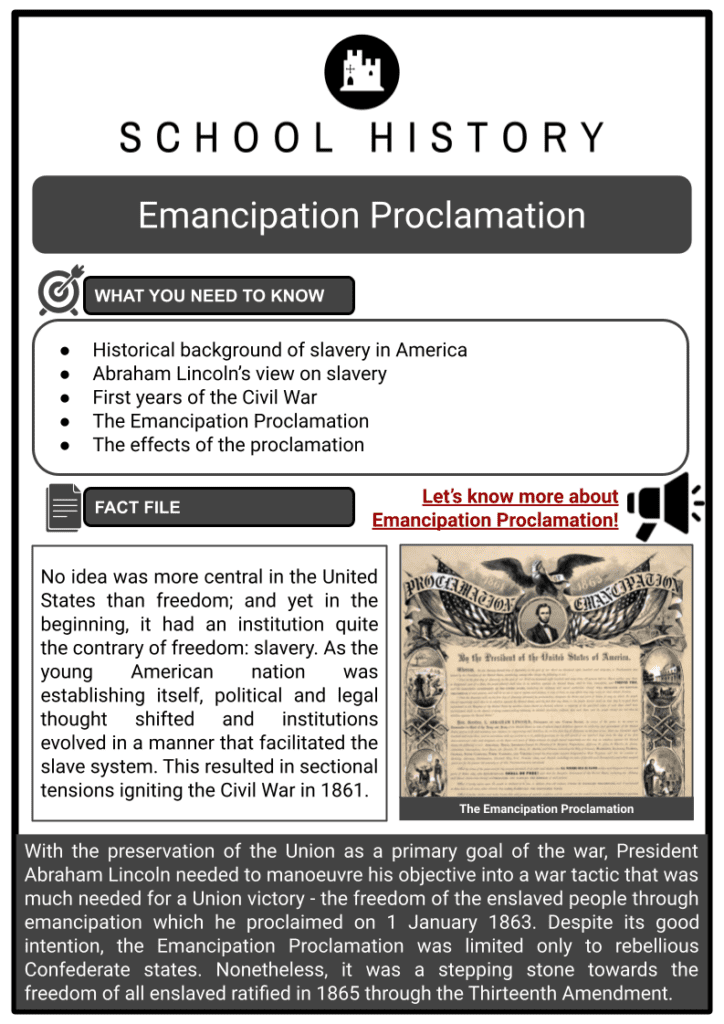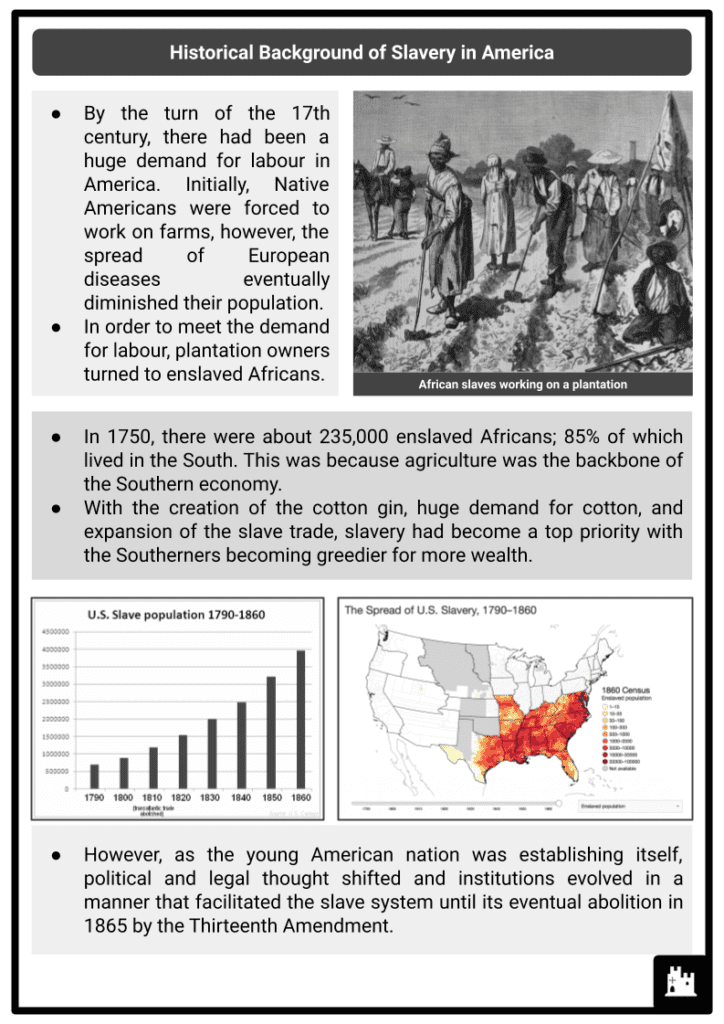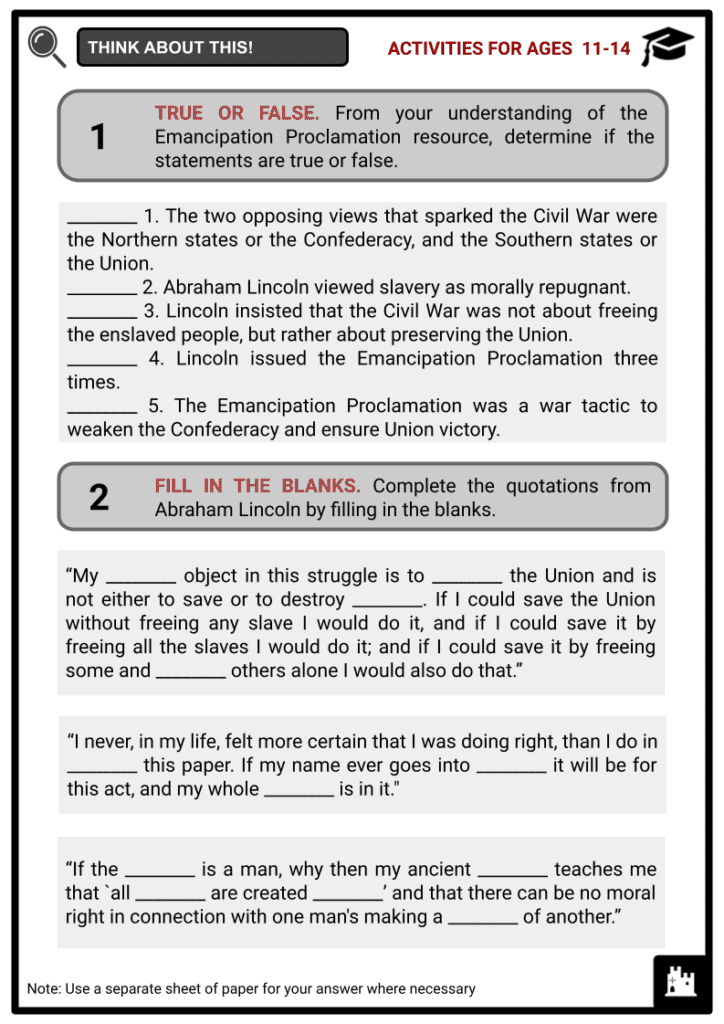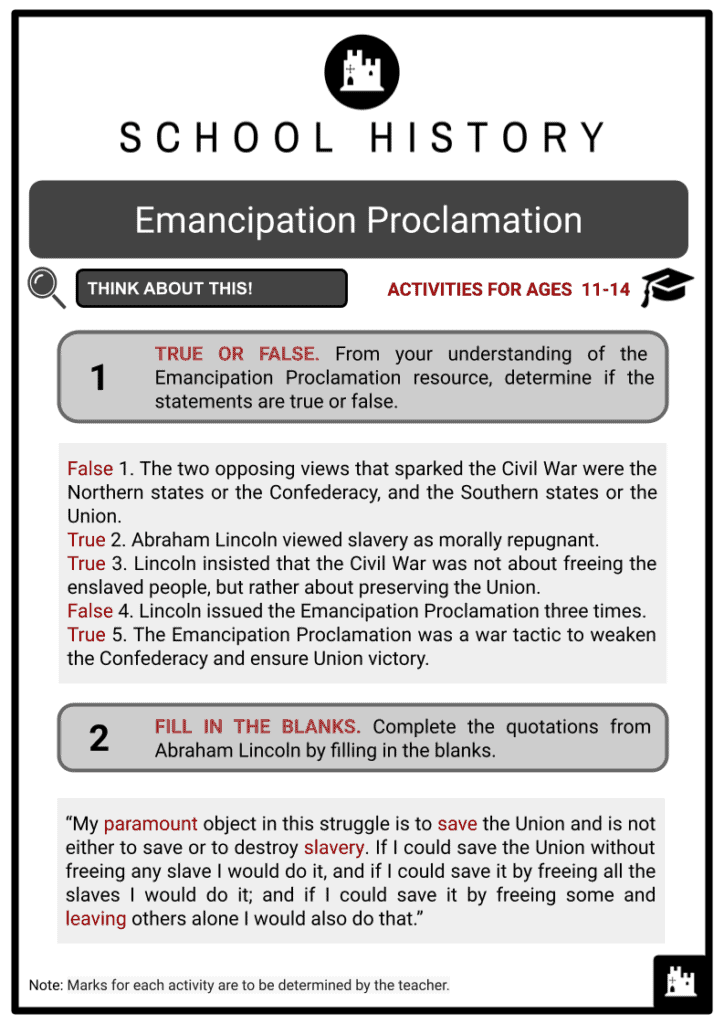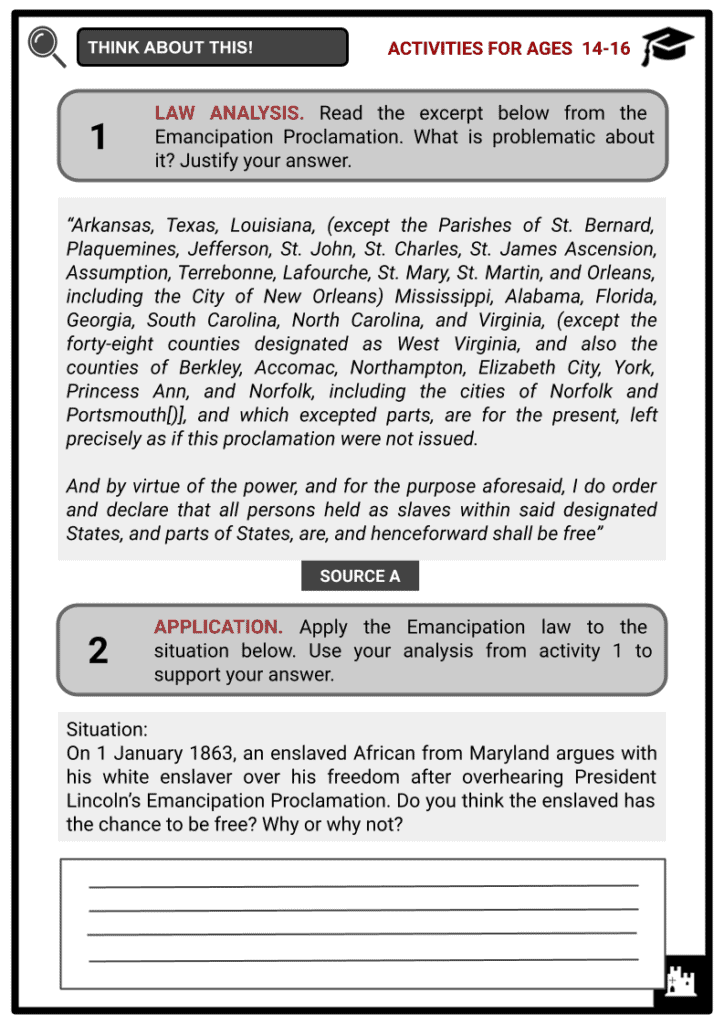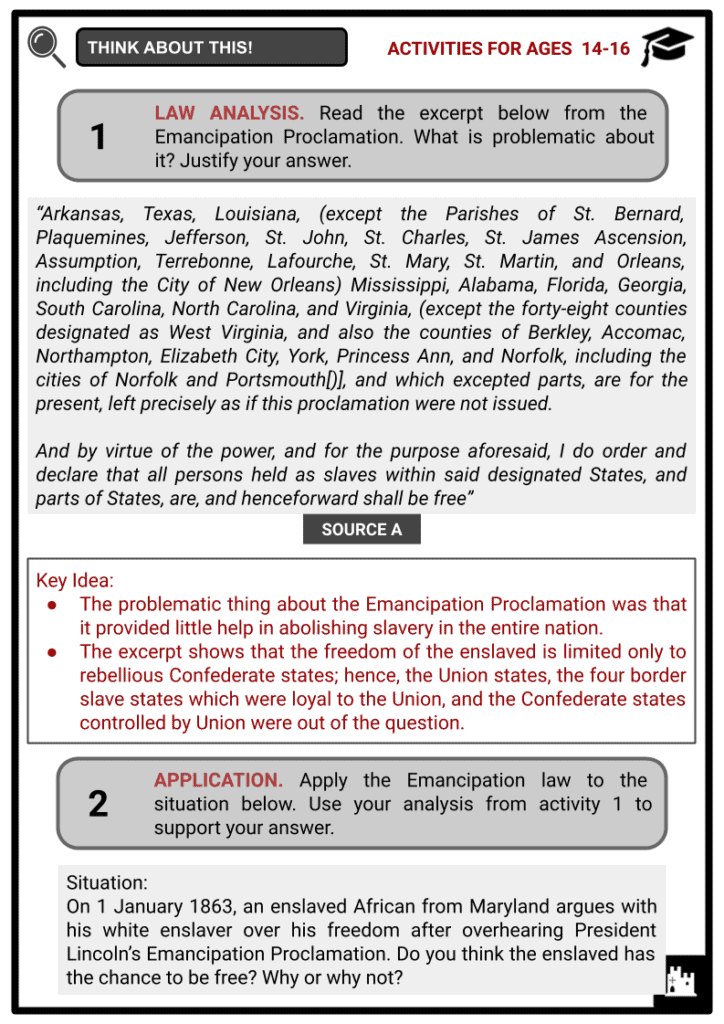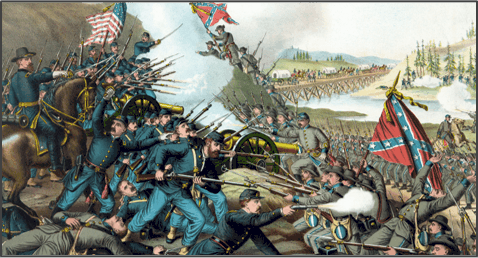Download Emancipation Proclamation Worksheets
Do you want to save dozens of hours in time? Get your evenings and weekends back? Be able to teach Emancipation Proclamation to your students?
Our worksheet bundle includes a fact file and printable worksheets and student activities. Perfect for both the classroom and homeschooling!
Table of Contents
Add a header to begin generating the table of contents
Summary
- Historical background of slavery in America
- Abraham Lincoln’s view on slavery
- First years of the Civil War
- The Emancipation Proclamation
- The effects of the proclamation
Key Facts And Information
Let’s know more about Emancipation Proclamation!
- No idea was more central in the United States than freedom; and yet in the beginning, it had an institution quite the contrary of freedom: slavery. As the young American nation was establishing itself, political and legal thought shifted and institutions evolved in a manner that facilitated the slave system. This resulted in sectional tensions igniting the Civil War in 1861.
- With the preservation of the Union as a primary goal of the war, President Abraham Lincoln needed to manoeuvre his objective into a war tactic that was much needed for a Union victory - the freedom of enslaved people through emancipation which he proclaimed on 1 January 1863. Despite its good intention, the Emancipation Proclamation was limited only to rebellious Confederate states. Nonetheless, it was a stepping stone towards the freedom of all enslaved ratified in 1865 through the Thirteenth Amendment.
Historical Background of Slavery in America
- By the turn of the 17th century, there had been a huge demand for labour in America. Initially, Native Americans were forced to work on farms, however, the spread of European diseases eventually diminished their population.
- In order to meet the demand for labour, plantation owners turned to enslaved Africans.
- In 1750, there were about 235,000 enslaved Africans; 85% of which lived in the South. This was because agriculture was the backbone of the Southern economy.
- With the creation of the cotton gin, huge demand for cotton, and expansion of the slave trade, slavery had become a top priority with the Southerners becoming greedier for more wealth.
- However, as the young American nation was establishing itself, political and legal thought shifted and institutions evolved in a manner that facilitated the slave system until its eventual abolition in 1865 by the Thirteenth Amendment.
- Two opposing views emerged: The Northern states or the Union who were more industrialised and were anti-slavery; and the Southern states or the Confederacy who were more economically dependent on plantations and were pro-slavery.
- Despite the numerous compromises made to settle the sectional tensions over slavery in the United States, the conflict grew and became the start of a Civil War.
Abraham Lincoln’s Views on Slavery
- By 1854, sectional conflicts over slavery were high, mainly over the Kansas-Nebraska Act that repealed the Missouri Compromise as it enabled the territories of Kansas and Nebraska to decide independently whether to allow slavery within their borders.
- The Missouri Compromise was an 1820 law that admitted Missouri to the Union as a slave state, admitted Maine as a free state, and banned slavery from the remaining Louisiana Purchase lands located north of the 36º 30’ parallel.
- The opposition towards the act led to the creation of the Republican Party and “revived the failing political career of an Illinois lawyer named Abraham Lincoln, who rose from obscurity to national prominence and claimed the Republican nomination for president in 1860” (History.com editors).
- How was Abraham Lincoln able to rise to national prominence and claim Republican approval? It was all for his views on slavery being morally repugnant.
- Lincoln cemented his views on slavery being an immoral act to man during his 1854 speech in Peoria, Illinios. He stated that: “If the negro is a man, why then my ancient faith teaches me that `all men are created equal’ and that there can be no moral right in connection with one man's making a slave of another." - Abraham Lincoln 1854
- Despite hating slavery, however, Lincoln did not believe that “the Constitution gave the federal goverment the power to abolish it in states where it already existed, only to prevent its establishment to new western territories that would eventually become states” (History.com editors).
- Thus, in 1861, Lincoln declared that he had no capacity to interfere with slavery in the states where it existed.
- By this time, seven states had already seceded the Union and formed the Confederacy igniting a Civil War.
First Years of the Civil War
- During the war, Lincoln insisted that the war was not about freeing the enslaved, but rather, about preserving the Union. To quote Lincoln:
- “My paramount object in this struggle is to save the Union and is not either to save or to destroy slavery. If I could save the Union without freeing any slave I would do it, and if I could save it by freeing all the slaves I would do it; and if I could save it by freeing some and leaving others alone I would also do that.” - Abraham Lincoln 1862
- In July 1862, Congress passed two acts: The Militia Act that allowed black men to serve as labourers in the US armed forces; and the Confiscation Act that mandated enslaved people seized from Confederate supporters to be declared forever free.
- Abolitionists criticised Lincoln for not creating a stronger emancipation policy, to which Lincoln replied that saving the Union came first before anything else.
- Abolitionists were supporters of the Abolitionist movement that sought to end slavery.
The Emancipation Proclamation
- In late July 1962, Lincoln drafted a preliminary document of the Emancipation Proclamation, which some of his advisers supported.
- Others, however, were either apathetic or worried that the Proclamation was too radical.
- It was then that Lincoln took the advice of William Seward, his secretary of state that urged him to wait until a significant victory of the Union before announcing the emancipation.
- On 22 September, days after the Battle of Antietam in the Civil War, Lincoln announced the preliminary Emancipation Proclamation that called on the Confederacy to join the Union within 100 days or else their enslaved people would be declared “thenceforward, and forever free”.
- The Battle of Antietam provided the necessary Union victory, as advised by William Seward to Abraham Lincoln, to issue the Emancipation Proclamation.
- On 1 January 1863, 100 days after the preliminary emancipation, no Confederate states yielded.
- Lincoln, true to his word, signed the final Emancipation Proclamation.
- It changed the focus and legitimate aim of the war from preserving the Union, to the freedom of the enslaved people.
Text of the Final Emancipation Proclamation
- “That on the first day of January, in the year of our Lord one thousand eight hundred and sixty-three, all persons held as slaves within any State or designated part of a State, the people whereof shall then be in rebellion against the United States, shall be then, thenceforward, and forever free; and the Executive Government of the United States, including the military and naval authority thereof, will recognize and maintain the freedom of such persons, and will do no act or acts to repress such persons, or any of them, in any efforts they may make for their actual freedom.
- “That the Executive will, on the first day of January aforesaid, by proclamation, designate the States and parts of States, if any, in which the people thereof, respectively, shall then be in rebellion against the United States; and the fact that any State, or the people thereof, shall on that day be, in good faith, represented in the Congress of the United States by members chosen thereto at elections wherein a majority of the qualified voters of such State shall have participated, shall, in the absence of strong countervailing testimony, be deemed conclusive evidence that such State, and the people thereof, are not then in rebellion against the United States.”
- Now, therefore I, Abraham Lincoln, President of the United States, by virtue of the power in me vested as Commander-in-Chief, of the Army and Navy of the United States in time of actual armed rebellion against the authority and government of the United States, and as a fit and necessary war measure for suppressing said rebellion, do, on this first day of January, in the year of our Lord one thousand eight hundred and sixty-three, and in accordance with my purpose so to do publicly proclaimed for the full period of one hundred days, from the day first above mentioned, order and designate as the States and parts of States wherein the people thereof respectively, are this day in rebellion against the United States, the following, to wit:
- Arkansas, Texas, Louisiana, (except the Parishes of St. Bernard, Plaquemines, Jefferson, St. John, St. Charles, St. James Ascension, Assumption, Terrebonne, Lafourche, St. Mary, St. Martin, and Orleans, including the City of New Orleans) Mississippi, Alabama, Florida, Georgia, South Carolina, North Carolina, and Virginia, (except the forty-eight counties designated as West Virginia, and also the counties of Berkley, Accomac, Northampton, Elizabeth City, York, Princess Ann, and Norfolk, including the cities of Norfolk and Portsmouth[)], and which excepted parts, are for the present, left precisely as if this proclamation were not issued.
- And by virtue of the power, and for the purpose aforesaid, I do order and declare that all persons held as slaves within said designated States, and parts of States, are, and henceforward shall be free; and that the Executive government of the United States, including the military and naval authorities thereof, will recognize and maintain the freedom of said persons.
- And I hereby enjoin upon the people so declared to be free to abstain from all violence, unless in necessary self-defence; and I recommend to them that, in all cases when allowed, they labor faithfully for reasonable wages.
- And I further declare and make known, that such persons of suitable condition, will be received into the armed service of the United States to garrison forts, positions, stations, and other places, and to man vessels of all sorts in said service.
- And upon this act, sincerely believed to be an act of justice, warranted by the Constitution, upon military necessity, I invoke the considerate judgment of mankind, and the gracious favor of Almighty God.
- In witness whereof, I have hereunto set my hand and caused the seal of the United States to be affixed.
- Done at the City of Washington, this first day of January, in the year of our Lord one thousand eight hundred and sixty three, and of the Independence of the United States of America the eighty-seventh.
- The handwritten draft of the final Emancipation Proclamation was destroyed in the 1871 Chicago Fire.
- In addition to the proclamation, Lincoln also suspended habeas corpus, shut down opposing newspapers, and stopped the admission of West Virginia and Nevada to the Union.
- With the announcement of the Emancipation Proclamation about 200,000 African-Americans fought for the Union by the end of the war, thus, providing more force.
- Enslaved people believed that fighting for the Union meant fighting for their freedom.
- More enslaved people in the South escaped to free states and joined the Union army and navy.
Effects of the Proclamation
- Though there is good intention upon freeing the enslaved, the proclamation included nothing about Lincoln’s past views about progressive elimination of slavery.
- He then argued that the proclamation was nothing more than a wartime measure that was carefully drafted to be applied only to the rebellious Confederate states; hence, the Union states, the four border slave states which were loyal to the Union, and the Confederate states controlled by Union were out of the question.
- In layman’s terms, the Emancipation Proclamation was a war tactic to weaken the Confederacy and ensure Union victory.
- Normally, the American president had very little power of decree outside of what the Congress can allow. This, however, with the exception of wartime as the president serves as the commander-in-chief. The Emancipation Proclamation was one of those special laws that was enforced by the president’s executive war powers.
- With the proclamation, enslaved people were invited to serve in the Union Army.
- This was a brilliant tactic to increase manpower adding more to the fact that the enslaved people made up a large percent of the Confederacy’s population.
- The South was more or less under the state of turmoil; thus, ensuring Union victory.
- Moreover, the proclamation paved the way for formerly enslaved to fight for their freedom.
- The Emancipation Proclamation also prevented European nations, who were against slavery but traded with the South, from aiding the Confederacy.
- Amidst the limited measures of the proclamation, the concept of freedom drove federal troops, which now included African-Americans motivated by the prospect of liberation.
- Lincoln considered the Emancipation Proclamation as the crowning achievement of his presidency. To quote him:
- “I never, in my life, felt more certain that I was doing right, than I do in signing this paper. If my name ever goes into history it will be for this act, and my whole soul is in it." - Abraham Lincoln 1863
- Since the proclamation was a presidential order enacted using Abraham Lincoln’s executive wartime powers, it was not a law passed by Congress so in order to ensure permanence, an anti-slavery amendment needed to be passed. This then became the birth of the Thirteenth Amendment that abolished slavery throughout America in 1865.
- The Emancipation Proclamation, in effect, had little impact on the freeing of the enslaved people of the nation.
- Nevertheless, it was a symbolic moment that paved the way towards the abolishment of slavery which, under the Thirteenth Amendment, was ratified 2 years after.
Image sources:

